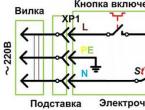History of Polish private housing construction and characteristic features of Polish houses. Projects of houses and cottages in the Polish style Ready-made house projects in Poland
Polish-style houses, distinguished by their originality and practicality, are quite popular among developers, including in 2018.
Ancient Polish houses were characterized by the use of exclusively natural materials; the roof had a complex structure with bull's-eye dormers and was covered with tiles. Columns were usually installed at the entrance. The facade was painted in light colors and decorated with stone and wood. The additional color was matched to the color of the roof.
The listed characteristics largely correspond to the architectural projects of private houses presented in this section of our catalog.
Plans for Polish house projects: what clients choose
However, much has changed since then, and the Polish style has also acquired modern architectural features. Now Poles prefer to buy houses in a European, modern, laconic style, characterized by restraint and simplicity. These are our Polish houses, photos, diagrams, preliminary designs, drawings and videos of which can be viewed on our website. In addition, the cost of building new cottages for such projects is often profitable.
Modern developers choose projects that meet the following requirements:
- project of a one-story private house or a house with a residential attic;
- the area of the house is at least 120 square meters;
- roofing of a gable and hipped type (but recently there has been a tendency to build turnkey houses with a flat roof);
- a house with large windows or panoramic glazing, which provides good natural lighting to the room.
Also in great demand among developers is the layout of Polish house projects with 2 bathrooms and at least three bedrooms.
Differences between modern Polish houses and traditional ones
Since the Poles are not used to luxury when it comes to housing, they limit themselves to economical construction solutions. Therefore, the modern design of Polish houses has the following individual differences:
- Instead of natural roofing materials, materials imitating tiles are used;
- Elements imitating stone and wood are used to decorate the exterior;
- The additional color of the façade design is matched to the color of the roof;
- Complex details are omitted from the roof structure: balconies, bay windows, etc.;
- Columns are missing.
Most often, the house design does not include a built-in garage. The layout of the interior of such a house is ergonomic and functional.
Polish house projects: adaptation and additional services
All Polish house plans presented on our website were developed by the best Polish architects taking into account European design standards. Therefore, before you receive the project, it undergoes adaptation to comply with all Russian SNiPs. In this case we change:
- location and size of the boiler room (if necessary);
- floor heights, wall pies, roofing pies;
- the height of the attic wall (if necessary).
Accordingly, after such changes in the architecture, our designers recalculate all loads and create a structural section of the project from scratch. Also, all engineering sections are created from scratch.
At the request of the developer, for an additional price, the company’s architects adapt original and standard Polish house designs to the climatic conditions of the development region. Our specialists can make changes to a finished Polish house project without compromising the strength and reliability of the structure. Both the layout of Polish houses and building materials can change. By ordering the “” service, an approximate estimate for the project can be drawn up. You can view the list of all add-ons.
We wish you a pleasant viewing and are confident that you will be able to find a home in our collection that will make your dreams of owning your own home come true!
In the last 2-3 years, various options for modern architectural and design solutions have begun to be used in private housing construction. One of these is the Polish house project. The popularity of buildings erected in this style is constantly growing.
| Project No. 57-13K | Project No. 57-02L | Project No. 57-11K |
Key Features
 The main feature of design in the Polish style is brevity and practicality. This combines Polish designs with European style designs. Finished house designs in the Polish style have the following characteristic features:
The main feature of design in the Polish style is brevity and practicality. This combines Polish designs with European style designs. Finished house designs in the Polish style have the following characteristic features:
- no more than two floors, and more often - one floor with an attic;
- small area, rarely exceeding 170-180 sq.m.;
- two- or four-slope roof without architectural frills (bay windows, broken shape, etc.);
- large windows or panoramic glazing;
- the use of materials that imitate natural tiles or stone.
There are no clear standards that Polish house and cottage projects must comply with. The main emphasis is always on restraint and economy, which helps reduce the final cost of construction.
Examples of Polish cottage projects
A striking example of Polish style - Project No. 57-06. The designed building has the following features:
- small area (175.08 sq.m.);
- one floor;
- use of metal tiles for roofing;
- the use of decorative stone on the facade;
- the kitchen and dining area are combined into one spacious room (28.6 sq.m.)
The photo shows another characteristic feature of the architectural style in question - when decorating the facade, the same colors are used as on the roof.
Project No. 57-06Project No. 47-21 demonstrates another feature of Polish design. Despite the full two floors, the building area is only 114 sq.m. The cleverness of the layout is manifested in the location of recreation areas on the second floor and active pastime areas on the first floor. The house has large windows, and artificial stone is used to decorate the basement. The area of the kitchen-dining room is 18.57 sq.m., which is a significant share of the total. The laconicism of the applied planning solutions made it possible to reduce the ineffective area of the hall (11.18 sq.m.) and stairs. The house does not have a garage.
Polish cottage projects have a number of characteristic features for which they are chosen for the construction of buildings all over the world. This:
Low number of storeys. As a rule, there are 1 or 2 floors, while Polish house designs with an attic are not uncommon. But such houses are practically not planned with a garage, which is partly due to the small area of the plot, and partly, according to the Poles, to the non-primary importance of this functional element.
Small area. Usually it does not exceed 120-150 sq. m. However, Polish-style house designs can hardly be called cramped, which is facilitated by the special
Layout. The center of such a house is a spacious living room, in which a work area with a computer desk and bookshelves can be organized at the same time. The kitchen is also made quite large (in relation to the total area) - 12-15 m2. But the bedrooms are compact and maximally functional, designed for a family with 2-3 children. A special feature is 2 bathrooms, on each floor (if there are 2).
Already from the above we can conclude that the main concept is efficiency. At the same time, you will probably be surprised to see a cottage project in the photo - the Polish version! - with a winter garden, sauna, garage. The fact is that Shop-project presents projects from Polish bureaus, adapted to the conditions of our country and the requirements of most customers, including the inclusion of popular functional elements.
Thus, Polish projects of one-story and two-story houses, without a garage or with a garage, do not demonstrate the actual “dry” economy, but rather the rational distribution of resources. This is reflected both in construction and in operation. For example, modern Polish houses are aimed at the European building materials market and provide excellent thermal insulation, which in turn allows you to save on heating and air conditioning. Considering the jumps in tariffs and the appetites of payment systems, quality will probably not be out of place in Russia.
In addition to ready-made projects, Shop-project offers individual design, taking into account the parameters that are important to you.
Features of private Polish houses.
Before the collapse of the Russian Empire, which included Poland (Rzeczpospolita), due to significant property stratification in Poland, the basis for private development was 2-4 room wooden houses of ordinary people and stone mansions of the aristocracy.
In the pre-war period (before World War II), with the growing prosperity of the Polish population and a reorientation to Western (German) housing construction standards, the most popular houses became stone plastered houses, in which toilets and bathrooms appeared.
After World War II in Poland, as a result of the active growth of the middle class, brick houses became popular. They were usually built from large-format ceramic blocks and plastered inside and out. Houses of this period of construction had basement floors, half buried in the ground, where there were storage rooms, a garage and, often, a second or summer kitchen.

Features of Polish house-building in the post-war period include the appearance of separate kitchens on different floors, which were organized with the aim of creating separate living areas for different generations of the family, who, for economic reasons of the socialist model, could not separate from their parents and build their own house. In addition, this layout made it possible to rent out part of the house to provide the family with additional income.

At the end of the 1980s, thanks to financial assistance from the USSR and the issuance of loans for the construction of houses, there was a boom in private housing construction. During this period, private Polish houses appeared, the features of which were not only traditional Polish practicality, but also the desire to impress neighbors. Saunas and relaxation rooms began to appear in the basement floors of such houses. A distinctive feature of Polish houses of the socialist period remained simple “square-nested” layouts, in order to minimize the cost of building a foundation.

After breaking the socialist impasse, the welfare of Poles began to grow rapidly, which allowed many families to finally build their own residential buildings or acquire a second home for a seasonal holiday.

Modern Polish houses are no longer boxy, tasteless houses built to save money on the foundation, but beautiful buildings with complex configurations. As a rule, these are spacious one or two-story houses. Such houses have large entrance halls, spacious living rooms, bathrooms with corner baths.

Polish houses are mainly built from large-format ceramic blocks, aerated concrete or expanded clay concrete blocks.

At the same time, in Poland there is often a strange desire to reinforce aerated concrete masonry with a reinforced concrete frame, which is not required by the technology of constructing low-rise buildings from aerated concrete.

In the same way, Polish builders try to reinforce brick walls with reinforced concrete frames, as if the houses they build are being built on mountain slopes or in earthquake-prone areas.

The walls of Polish houses are plastered - the cheap vinyl siding popular in Russia is not to the taste of modern Poles. You rarely see unreliable corrugated cellulose-bitumen roofing sheets on roofs - in Poland they prefer metal tiles, cement-sand or natural tiles.

The layered rafter system is almost universally used, which makes it possible to effectively use the space of the attic floor due to the absence of tie rods.

By the way, even poor Poles who do not have enough money to purchase local treatment facilities do not use the “septic tanks made of concrete rings” that are ubiquitous in Russia due to total environmental illiteracy, which contaminate the soil and groundwater with feces, but purchase monolithic reinforced concrete tanks for the construction of cesspools.

Construction of houses in Poland is a profitable business - there are houses built for sale everywhere.

The facades and roofs of houses based on Polish designs are distinguished by their complex configuration, which makes the house “interesting” to the eye of the observer.

Polish house designs are distinguished by their practicality and aesthetic appearance, which are far removed from the “shoebox” and “transformer booth” houses of the era of developed socialism, which for some reason are still popular in Russia.

The most attractively decorated roadside restaurants in Poland are taverns, built in the “historical style” in the form of wooden houses with reed roofs.

By the way, the food in Polish taverns is inexpensive and very tasty).

Andrey Dachnik
Every year, Polish house and cottage projects become more in demand and popular in the European Union and CIS countries. They are distinguished by their aesthetic appearance, practicality and affordable cost. Buildings of various configurations are presented to clients, among which everyone can choose the ideal home for themselves and their family.
Exterior of Polish houses and cottages
Ancient Polish stone buildings were decorated with columns and decorated with wood. This gave them a special flavor characteristic of the culture of the people.
The new houses have acquired modern European features, making them no less beautiful. In recent years, Poles have preferred a laconic, restrained style. This trend continues in 2019.
Today, typical Polish houses and cottages meet the following requirements:
- building plot of at least 120 square meters;
- large windows providing excellent lighting to the rooms;
- one or two floors, most often with an attic;
- gable or hipped roof;
- a porch that harmoniously fits into the overall composition of the building.
Projects of houses and cottages with several bathrooms, three bedrooms, a spacious living room, kitchen and corridor are in great demand.
Important aspects are rational distribution of resources and convenience. For the construction of premises in a modern style, European materials are used, providing excellent thermal insulation. This allows you to always maintain a comfortable temperature and save on utility bills.
The project of a Polish house can be made from any building materials at the request of the client.
Free layout, high performance characteristics, original design make them competitive in the world market. Nowadays there is a demand for small houses for a family of several people with a garage, where all the premises are located compactly and do not include anything superfluous.
Construction Features
The modern house, made according to a Polish design, has 1 or 2 floors. At the initial stage of construction, hollow blocks with a ceramic base and the classic frame technique are usually used.
In luxury cottages, standard tiles are used as roofing, which have a beautiful appearance and a long service life. Cheaper private house projects use inexpensive components that allow you to fit into a limited budget without compromising the quality characteristics of the building.
One-story houses
Projects of one-story houses are designed for representatives of the middle class and fully satisfy the needs of the average family of several people. Typically this is a compact house with an area of 120-150 square meters, built from available materials.
Most often, a frame is used, which provides a low load on the foundation and eliminates the need to involve complex technological equipment in construction. It makes it possible to realize all the customer’s wishes, which cannot always be fulfilled using stone.
The hallmark of a Polish house is its complex roof. Even in the most budgetary construction, traditional features are preserved, by which it is easy to recognize the features of national construction.
In low-cost houses, the architect's design does not include a basement floor, a built-in garage, or numerous balconies. The second floor is replaced by a bright, cozy attic.
Most often, the exterior of a one-story house is decorated with a wide terrace with a canopy and canopy, which is part of the overall composition of the building. At the request of the customer, it can be connected to the central porch or located at the back of the house, making there an exit from the kitchen or dining room.

Two-story houses
Building a two-story house requires significant financial costs and takes a lot of time. Such a project usually includes:
- minimum 4 bedrooms;
- spacious bathrooms;
- study;
- living room;
- kitchen;
- dining room;
- other premises at the request of the client.
A two-story building often has a basement where recreational rooms are located, such as billiards, a gym, a swimming pool or a home theater. The building includes a built-in garage for 1 or 2 cars and a wide porch with a terrace.
Two-story projects are in demand among wealthy people and those who like to receive guests and have a lot of free space to implement the most daring design ideas.
In Poland, not only the design of private houses and cottages is developing. The priority here is the construction of multi-apartment buildings that meet European standards.
Not far from the center of Warsaw, a new microdistrict is under construction - Żoliborz Artystyczny. All the houses here were built using monolithic frame technology and consist of 5-6 floors. The future owner of the living space can make changes to the apartment plan, move walls, or include an additional bathroom in the project. To do this, you only need to obtain the investor’s consent.
Most apartments have a small area. It is not customary in the country to design overly large premises. Every square meter is used rationally here.
How do modern Polish houses differ from traditional buildings?
Traditional Polish houses built several decades ago were made of natural brick, the balconies and roof included complex structures, such as a dormer window that resembled a bull's eye from a distance. Modern private cottages do not have such elements.
To make a roof, materials that imitate tiles are often used. For exterior decoration, plastic is in demand, visually reminiscent of wood or stone. The façade is designed to match the color of the roof. There are no columns or other complex configurations in the project.
Modern Polish houses have many layout options and meet strict fire safety requirements, which is an additional advantage that increases their popularity.
Conclusion
Designing Polish houses and cottages is a profitable business that is growing rapidly. At the request of the client, the architect can make changes to the original development plan and adapt it to the climatic conditions of the region of residence.
Apartment in Krakow: Video




